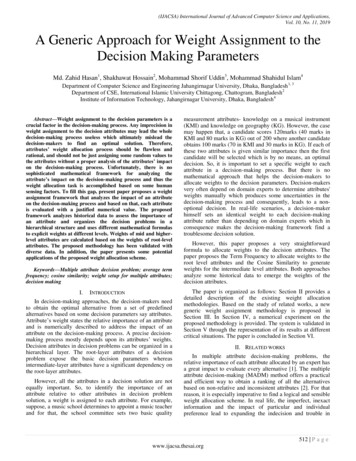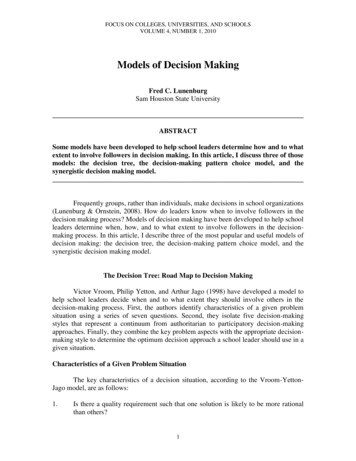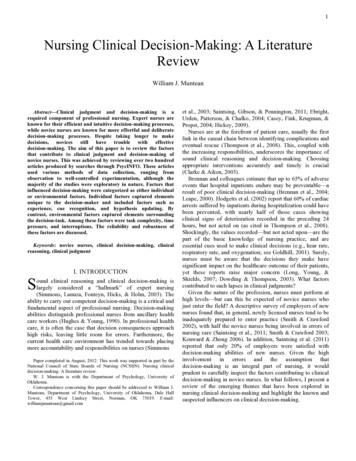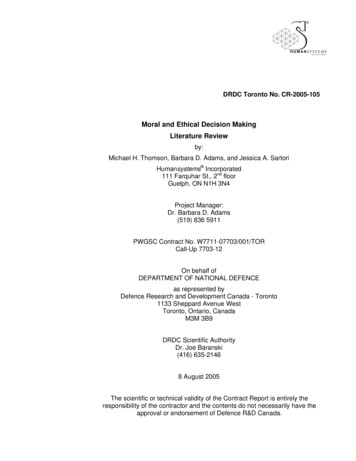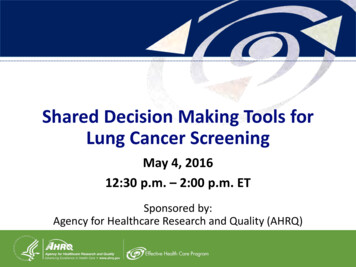
Transcription
Shared Decision Making Tools forLung Cancer ScreeningMay 4, 201612:30 p.m. – 2:00 p.m. ETSponsored by:Agency for Healthcare Research and Quality (AHRQ)
SHARE Approach Webinar SeriesWebinar 5Shared Decision Making Tools forLung Cancer ScreeningOther Webinars available tml2
Presenters and moderator Monique D. Cohen, Ph.D., M.P.H. (Moderator) Agency for Healthcare Research and Quality Robert J. Volk, Ph.D. John M. Eisenberg Center for Clinical Decisions andCommunications Science, The University of Texas MDAnderson Cancer Center Richard L. Street, Ph.D. John M. Eisenberg Center for Clinical Decisions andCommunications Science, Texas A&M University, and BaylorCollege of Medicine3
DisclosuresThe presenters and moderator have no conflicts of interest todisclose:This continuing education activity is managed and accreditedby Professional Education Services Group (PESG) incooperation with AHRQ. PESG, AHRQ, and all accreditingorganizations do not support or endorse any product orservice mentioned in this activity.PESG, AHRQ, and AFYA staff have no financial interest todisclose.Commercial support was not received for this activity.4
Accreditation Accredited for: Physicians/Physician Assistants, Nurse Practitioners,Nurses, Pharmacists/Pharmacist Technicians, HealthEducators, and Non-Physician CME Instructions for claiming CME/CE – provided atend of Webinar5
How to submit a question At any time during thepresentation, type yourquestion into the “Q&A”section of your WebEx Q&Apanel. Please address yourquestions to “All Panelists” inthe dropdown menu. Select “Send” to submit yourquestion to the moderator. Questions will be read aloudby the moderator. SHARE@ahrq.hhs.gov6
Learning objectivesAt the conclusion of this activity, participants will be able to:1.2.3.Explain how shared decision making can be helpful to patients andproviders in deciding whether to participate in lung cancer screening.Describe the key components of an effective lung cancer screeningtoolkit for use in primary care settings.Explain how using an effective decision aid and other tools can meetthe shared decision making and patient counseling visit requirementsof the Centers for Medicare & Medicaid Services (CMS) for Medicarecoverage of lung cancer screening with low-dose computedtomography.7
AHRQ’s Effective Health Care Programhttp://www.effectivehealthcare.ahrq.gov/8
Shared Decision Making Tools forLung Cancer ScreeningRobert J. Volk, Ph.D.John M. Eisenberg Center for Clinical Decisions and Communications ScienceThe University of Texas MD Anderson Cancer CenterRichard L. Street, Ph.D.John M. Eisenberg Center for Clinical Decisions and Communications ScienceTexas A&M University and Baylor College of Medicine
Let’s begin with a case A 60-year-old female presents for a periodic healthexamination. She mentions seeing a large billboardalong the highway, showing 99 lung cancerscreenings at a local medical facility. She asks,“Doc, should I get that lung screening test? I’vebeen smoking for 40 years.” What do you recommend?10
The National Lung Screening TrialMain findingspublished in 2011.Randomized 53,000heavy smokers to Reduced lung cancer deathsby 16-20%.A game changer! Low-dosecomputedtomography(LDCT) or chest xray 3 annual screens Followed 6.5 yearsNNS 320NLST Research Team, NEJM 2011; Bach, Jama 2012; Pinsky, Cancer, 2014.11
The National Lung Screening TrialBut lung cancer screening with LDCT carriespotential harms: Radiation exposure (?) High positive rate: 20-25% per scan 40% if screened annually for 3 years Invasive procedures Incidental findings (may be a benefit) Overdiagnosis rate estimated at 10-20%NLST Research Team, NEJM 2011; Bach, Jama 2012; Pinsky, Cancer, 2014.12
Response from the health care communityDirect-to-consumer marketing campaignsNew Clinical GuidelinesACS, ASCO, ACCP, NCCN (2012, 2013)All emphasize the importance of aninformed/shared decision making process!Smoking cessation/abstinenceis essential!13
Lung cancer screeningrecommendationsReleasedDecember2013 Update of 2004 recommendation Triggered largely by publication of NLST Used comparative modeling to determine optimalscreening strategy—Most efficient strategy: interval, age atinitiation/stopping, pack-year threshold, years since quitMoyer, Ann Intern Med 2014; de Koning, Ann Intern Med 2014.14
USPSTF Recommendation:Lung Cancer Screening – December 2013 The USPSTF recommends annual screening forlung cancer with low-dose computed tomography(LDCT) in adults aged 55 to 80 years who have a30 pack-year smoking history and currentlysmoke or have quit within the past 15 years. Screening should be discontinued once a personhas not smoked for 15 years or develops a healthproblem that substantially limits life expectancy orthe ability or willingness to have curative ce.org/15
USPSTF Recommendation:Lung Cancer Screening – December 2013 Other considerations: Smoking cessationcounseling1. Persons referred by a PCP should receivecounseling before referral.2. For persons who present for screening without areferral (e.g., “self-refer” to a screening center),incorporating smoking cessation counseling isencouraged.Moyer, Ann Intern Med 2014.16
The importance of the USPSTF Is a trusted, unbiased developer of evidence-basedclinical preventive services recommendations Greatly impacts recommendations fromprofessional organizations and (potentially) clinicalpractice NEW: ACA mandates first-dollar coverage for allpreventive services that receive a Grade A or Brecommendation from the USPSTF.A’s and B’s are now covered without copay!17
CMS National Coverage Determination –February 5, 2015 It’s the first covered service that explicitly requires shared decision making. The visit for counseling and shared decision making is reimbursed by details/nca-decision-memo.aspx?NCAId 27418
CMS – Criteria for lung cancer screening:Beneficiary eligibility Age 55 – 77 years Asymptomatic (no signs/symptoms of lung cancer) 30-plus pack-year smoking history Current smoker or quit within the last 15 /details/nca-decision-memo.aspx?NCAId 27419
CMS – Criteria for lung cancer screening:Beneficiary eligibility Written order for LDCT: Initial service: Beneficiary receives written order duringlung cancer screening and shared decision making visitfrom physician or qualified non-physician. Subsequent service: Beneficiary receives written orderduring any appropriate visit from physician or NCAId 27420
Lung cancer screening counselingand shared decision making visit1. Determination of beneficiary eligibility Age Absence of symptoms “Specific calculation of cigarette smoking pack-years” Number years since quitDocumented in medical e/details/nca-decision-memo.aspx?NCAId 27421
Lung cancer screening counselingand shared decision making visit2. Shared decision making, including: Use of 1 or more decision aids, to include Benefits, harms, follow-up diagnostic testing, over-diagnosis, falsepositive rate, total radiation exposureDocumented in medical e/details/nca-decision-memo.aspx?NCAId 27422
Lung cancer screening counselingand shared decision making visit3. Counseling on importance of adherence to annualLDCT, impact of comorbidities, and ability orwillingness to undergo diagnosis and treatment.Documented in medical e/details/nca-decision-memo.aspx?NCAId 27423
Lung cancer screening counselingand shared decision making visit4. Counseling on importance of maintaining cigaretteabstinence, or furnishing information about tobaccocessation services.Documented in medical e/details/nca-decision-memo.aspx?NCAId 27424
Lung cancer screening counselingand shared decision making visit5. “If appropriate,” furnishing a written ordercontaining the following: Date of birth Actual pack-year history (number) Current smoking status, number years since quit Statement beneficiary is asymptomatic National Provider Identifier (NPI) of ordering atabase/details/nca-decision-memo.aspx?NCAId 27425
Radiologist eligibility criteria Certified by American Board of Radiology. Documented training in diagnostic radiology andradiation safety. Supervision/interpretation of 300 chest CTacquisitions in past 3 years. Participation in CME in accordance with database/details/nca-decision-memo.aspx?NCAId 27426
Radiology imaging center criteria Performs LDCT with volumetric CT dose index. Utilizes standardized nodule identification system. Makes available smoking cessation interventions forcurrent smokers. Collects/submits data to national registry for eachLDCT lung cancer screening abase/details/nca-decision-memo.aspx?NCAId 27427
Medicare coverage of screening for lung cancerwith low-dose computed tomography (LDCT)Health Care Common Procedure Coding System (HCPCS) Codes G0296 – Counseling visit to discuss need for lung cancerscreening LDCT (service is for eligibility determination andshared decision making) G0297 – LDCT for lung cancer Downloads/mm9246.pdfFinding ACR Designated Lung Cancer Screening r-ScreeningRegistries.html28
Screening on a national scale New clinical recommendations place primary careclinicians at the forefront of implementing lungcancer screening on a national scale. But are we ready? The Eisenberg Center has developed a newimplementation toolkit for primary care clinicians.29
Shared decision making is fundamentallya communication activity Shared decisions require good communicationbetween clinicians and patients. Decision aids provide a structured approach toproviding information about options and tradeoffs, values related to options and outcomes, andcan help foster deliberation. But, decision aids are not sufficient to ensure ahigh-quality shared decision making process.30
Developing a new toolkit Provide clinicians with a concise summary of thecurrent clinical evidence and recommendations. Provide a way to ensure the patient counselingand shared decision making visit is consistent withCMS beneficiary eligibility criteria. A high-quality patient decision aid is needed butnot enough. Create decision support tools in multiple formatsand for use in multiple ways to supportdeliberation between patients and clinicians.31
Implementation needs of primary care clinicians Clarity about the guidelines/recommendations Eligibility, when to start/stop Clarity about insurance/Medicare coverage Who pays for what? Finding screening centers for referral Where to send interested/eligible patients? Patient educational tools/decision aids Integrating screening programs with EHRs Training for clinic staff in implementation Toolkits to help with implementationVolk et al., Preventive Medicine Reports, 2015.32
Released March reening/33
AHRQ: Effective Health Care Programpatient decision -and-resources/patient-decision-aids/34
Components of lung cancer screening creening/35
Components of lung cancer screening creening/36
Components of lung cancer screening creening/37
Summary guide for clinicians38
Summary guide for clinicians39
Summary guide for clinicians40
Summary guide for clinicians41
Summary guide for clinicians42
Summary guide for clinicians43
A clinician’s checklist44
A clinician’s checklist45
A decision aid for patients46
A decision aid for patients47
A decision aid for patients48
A decision aid for patients49
A decision aid for patients50
A decision aid for patients51
A decision aid for patients52
A decision making tool forthe clinical encounter53
Communication strategies with patients1. Provide clear information Risks and benefits of lung cancer screening(see Checklist Talking Points) Use everyday language, pictures, graphs, example,analogies, stories (communicating ‘gist’) How do you know your message is clear? Check forpatient understanding. Examples: “I know you’ve gotten a lot of information. What stands out asparticularly important to you?” “So we’ve talked about possible harms of LCS. What do youthink about those risks?”54
Communication strategies with patients Remember: Information has no meaning until someone tries tomake sense of it. There is no one way to provide clear information;the key is to provide information in a way thepatient can understand it. It is important to check for patient understanding.55
Communication strategies with patients2. Elicit/validate a patient’s beliefs, concerns, andpreferences (or values) Ask what a patient thinks about lung cancerscreening by exploring beliefs, concerns, andpreferences (or values). But remember: Concerns and preferences are not misinformed; they aregrounded in a reality that is coherent, rational, andmeaningful to the patient. Try to connect clinical evidence to a patient’s values,preferences, and emotions.56
Communication strategies with patients Example Pt: “Well if lung cancer screening can save my life, thenthat sounds good.” Dr: “That’s right, it could save your life. But remember,the research indicates that out of 1,000 peoplescreened, 3 lives will be saved but 18 still died. Andabout 350 will have a false alarm, and some of thesepatients will have additional tests that can lead tocomplications.”“So what do you think when you compare the numbersof lives saved with false alarms?”57
Communication strategies with patients3. Try to reach mutual understanding andagreement Check your understanding of the patient’s perspective. “So what you’re saying is if there is at least some chance tosave your life, you want to do it even if the odds of a falsealarm are much greater?” “Let me see if I got this right. You think the likelihood thiscould save your life is quite small, and you really worriedabout what would happen with a false positive?” Check the patient’s understanding of what you haveshared with the patient, including any concerns youhave. “So you know what I’m concerned about?”58
Communication strategies with patients Strive for common ground on best courseof action. Mutually acknowledge the action to betaken. “Ok, we will schedule the screening sometime nextweek. So take this to the desk and they will set you upfor the appointment.” “So right now we are just going to wait. And we canrevisit the possibility of lung cancer screening at yournext appointment. Are we on the same page with that?”59
Additional considerations for lungcancer screening conversations The patient has a knowledge about LCS or hasreceived the decision aid before the consultation First, ask patient about his or her thoughts about LCS. This lets the clinician know what the patient understands andwhat their initial preferences are and why. If a patient has used the aid, but say he/she is not sure what tothink about it, then follow with a probe (“Well just tell me someof your thoughts about it.”) Fill in knowledge gaps and explore preferences/concerns. The patient has no or very limited knowledge ofLCS Use the decision-making tool in the encounter toeducate, identify concerns, and discuss preferences.60
In conclusion: How might thelung cancer screening tools be used? Adapt the tools for a variety of primary caresettings. Integrate the tools with electronic health records(Clinician’s Checklist). Adapt the tools for different patient populations. Couple the tools with clinician training in shareddecision making.61
Contact informationRobert J. Volk, Ph.D.The University of TexasMD Anderson Cancer CenterHouston, TXRichard L. Street, Jr., Ph.D.Department of CommunicationTexas A&M UniversityCollege Station, TXBVolk@mdanderson.orgr-street@tamu.edu62
Obtaining CME/CE credits If you would like to receive continuing educationcredit for this activity, please 3
How to submit a question At any time during thepresentation, type yourquestion into the “Q&A”section of your WebEx Q&Apanel. Please address your questionsto “All Panelists” in thedropdown menu. Select “Send” to submit yourquestion to the moderator. Questions will be read aloudby the moderator. SHARE@ahrq.hhs.gov64
Questions about AHRQ’s:SHARE Approach ProgramEffective Health Care Program /Lung Cancer Screening ToolsContact:Contact:Alaina FournierMonique Cohenalaina.fournier@ahrq.hhs.gov ORMonique.cohen@ahrq.hhs.gov ovAgency for Healthcare Research and Quality65
Obtaining CME/CE Credits If you would like to receive continuing educationcredit for this activity, please 6
current clinical evidence and recommendations. Provide a way to ensure the patient counseling and shared decision making visit is consistent with CMS beneficiary eligibility criteria. A high-quality patient decision aid is needed but not enough. Create decision support tools in multiple formats and for use in multiple ways to support







